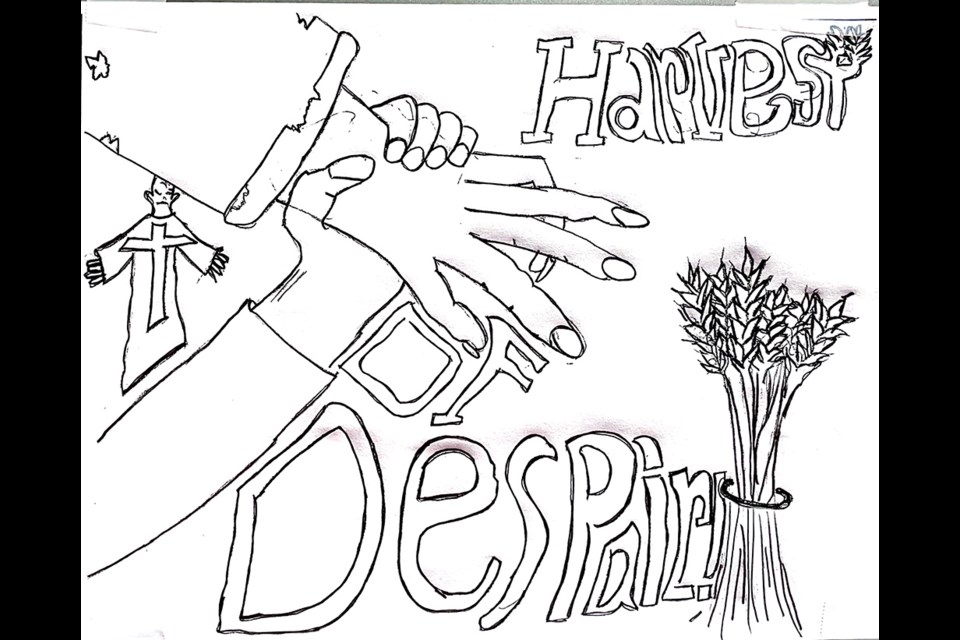THE BATTLEFORDS — The Saskatchewan government honoured the victims of Holodomor on Tuesday, Nov. 22.
The annual provincial commemoration of the Holodomor Ukrainian Famine-Genocide takes place at noon in the legislative rotunda followed by an outdoor wreath laying at the “Bitter Memories of Childhood” monument southeast of the legislature building.
Saskatchewan was the first province in Canada to formally recognize the Holodomor as a genocide with the passage of Bill 40: An Act to Recognize the Ukrainian Famine and Genocide (Holodomor)on May 7, 2008. Bill 40 had the unanimous support of all MLAs in the house. The bill enshrines the fourth Saturday in November of each year as “Ukrainian Famine and Genocide (Holodomor) Memorial Day.”
There will be a free showing of “Bitter Harvest” Saturday, Nov. 26, 4:30 to 6 p.m. at Capitol Annex Theatre in North Battleford. “Bitter Harvest” is a Hollywood film set in Ukraine 1932-1933. Film rating: is 14+. Nov. 26 is Canada’s national Holodomor Memorial Day
From Nov. 21 to 25, Schools across Canada are urged to include the Holodomor in their teaching, specifically Friday which is designated as Holodomor Memorial Day in Schools.
Holodomor Facts
The term “Holodomor” was not used until 1953. At the time, people said “the holod” or “the famine.” ‘Holod’ means hunger in Ukrainian.
- The region of Ukraine was part of the United Soviet Socialist Republic (USSR) at the time;
- Joseph Stalin’s five-year plan to collectivize all farmland according to the communist philosophy of the USSR was implemented 1929-34;
- Holodomor occurred in a time of peace, there was no official declaration of war or aggression against the region of Ukraine;
- The famine was not a result of natural disaster or crop failure;
- The height of the famine occurred in June 1933 when all hidden and remaining food stocks had been depleted;
- In June 1933 people were dying at the rate of 28,000 per day;
- Food shortages were created by government policy;
- The Law of Five Stalks was passed in August 1932 making it a crime for anyone, children included, to possess any more than five stalks of grain from a collective farm.
- Wheat and other foods were confiscated by communist military forces.
Print and Video
Learn more about the Holodomor through videos and books.
- “Bottle of Grain” historical fiction illustrated children’s book by Saskatchewan author, Rhea Good;
- 1953 – Raphael Lemkin, authority on international law, wrote “Soviet Genocide in the Ukraine” to commemorate the 20th anniversary of the Great Famine, as it was called at that time. Lemkin would later define the distinction between mass death and intentional genocide as “not simply a case of mass murder,” but “a case of genocide, of the destruction, not of individuals only, but of a culture and a nation.”;
- “Stalin’s Genocides” by Norman M. Naimark;
- “Stalinism, Collectivization, and the Great Famine” by Andrea Graziosi;
- “My Dearest Dido” historical fiction novel for young adults by Saskatchewan author, Marion Mutala.
Video available for viewing on YouTube:
- “Holodomor: Voices of Survivors” - a 30-minute documentary with firsthand accounts of 25 Canadian survivors who tell their stories as children during Holodomor;
- “The Soviet Story” – first 11 minutes are an excellent introduction to the historical background;
- “Hunger for Truth: The Rhea Clyman Story” – a Canadian journalist and eyewitness in Ukraine was among the first journalists to write about the conditions in Ukraine in 1932-1933.
Full length feature films:
•2020 – “Mr. Jones” – based on the career of Welsh journalist, Gareth Jones, who risks his life to expose the truth about the famine to the world;
• 2016 – “Bitter Harvest” – story begins before the Holodomor as two young adults fall in love before lives are torn apart as the winter of 1932-33 brings the unexpected and the unbelievable.



